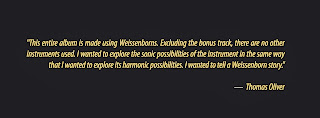What started as a single instrumental
and then became a collection for an EP, transitioned into a full and
conscious record that tells a story. Beneath the Weissenborn cuts its
own path musically with an honesty and quality that has made Thomas'
unique voice so beloved and identified with the world over.
Thomas is one of those most special and
beautiful people you meet in life who gives rather than takes, and
continually inspires through his own humility, artistic integrity and
positivity for life. It has been the greatest honor as a maker to
collaborate with him on various projects, and to see him record a
solid selection of guitars that I made (Styles 1, 2, 3 and 4
respectively) and restored (Weissenborn Teardrop, Ca.1930).
One of my favorite things about the album its how it takes you places within your own head and heart. The new video 'Born' so beautifully articulates the magic, innocence and complete enamor of how I felt about the Weissenborn when I first heard it, and why it continues to inspire my life on a daily basis. Thank you for all you have done for me, Thomas!
'Beneath The Weissenborn' is out today!




.jpg)